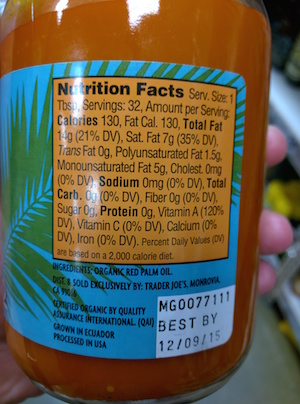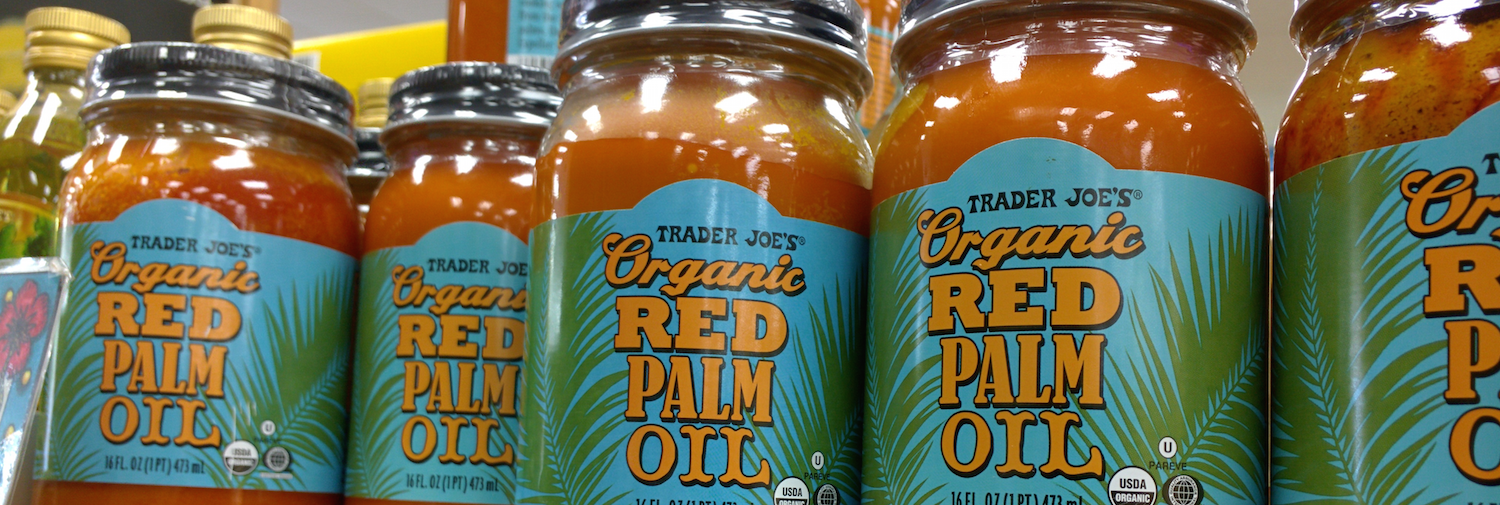 Have you noticed the Trader Joe’s Red Palm Oil on display front and center at your local Trader Joe’s this spring?
Have you noticed the Trader Joe’s Red Palm Oil on display front and center at your local Trader Joe’s this spring?
Despite multiple phone calls and emails, Trader Joe’s will not disclose its palm oil supplier. According to their website, its palm oil is sourced from plantations that come from land that was not cleared and is produced using organic, sustainable practices.
Unfortunately the term “sustainable” has been so overused as a greenwashing tactic by the palm oil industry that it is no longer a useful term to distinguish good palm oil from bad. This is why RAN is asking companies to use only ‘responsible’ palm oil, which is palm oil that has been produced legally and from known sources without contributing to deforestation, species extinction, high greenhouse gas emissions or human and labor rights violations. See RAN’s Conflict Palm Oil report for more information.
Although it seems like Trader Joe’s red palm oil is produced in a better way than most palm oil on the market, it’s important to note that a large percentage of its other branded products contain palm oil whose sourcing is unknown. In order to ensure it is not connected to controversy, Trader Joe’s must adopt and rapidly implement a responsible palm oil policy that covers all products in the store.
Trader Joe’s needs to understand that orangutan extinction and deforestation in Southeast Asia aren’t the only negative impacts associated with palm oil production. The U.S. government has highlighted the prevalence of human-rights abuses in the global palm oil trade: A 2012 U.S. Department of Labor report found that palm oil was among the industries most notorious for forced and child labor.
Is palm oil healthy?
Palm oil may be a good industry substitute for trans fats as it stays solid at room temperature without hydrogenation, but it isn’t actually a healthier alternative: A 2009 study by the federal Agricultural Research Service found that palm oil isn’t a good substitute for trans fats because consuming either type of fat results in similar spikes in artery-clogging LDL (“bad”) cholesterol and a protein (apolipoprotein B) that distributes it throughout the bloodstream.
Red palm oil is less refined than conventional palm oil or palm kernel oil, which does keep some of the micronutrients intact – specifically Vitamin E, Vitamin A and carotenoids (which give it its color). But if you’re eating for these specific nutrients, palm oil isn’t an ideal choice because it’s so high in saturated fats. If you’re trying to increase your Vitamin E, A and carotenoids better to eat fruits, vegetables, seeds and nuts. Hear it from our nation’s expert dietitians themselves.
And just to clarify, many red palm oil brands that are marketed as “healthy” come straight from the Conflict Palm Oil plantations of Malaysia and Indonesia. So just because you’re eating red palm oil doesn’t mean it’s conflict-free!
The majority of palm oil found in the food products (and “food like substances”, a term Michael Pollan uses to refer to the vast array of palm-oil laden packaged, processed snack foods found in a bag or box) we buy at grocery stores is heavily refined with bleaching and not good for our health. First of all, bleaching eliminates carotenoids and tocopherols. Secondly, most of the food products you find palm oil in, your body could do without. In 2014 Dr. Weil joined a chorus of leading health experts in warning Americans about the dangers of eating refined palm oil.
Factoring in the environmental footprint of palm oil production, palm oil is neither healthy for our bodies nor the planet. It’s best to limit consumption of foods that contain palm oil (especially processed snacks and packaged baked goods) and eat more whole foods. Eating a plant-centered diet, one that favors organic whole grains, fruits, vegetables, legumes, beans, nuts and seeds, benefits our planet and our health.
The Serious Climate Foodprint of Palm Oil and Meat
Altogether, our industrial agriculture system is driving a whopping one third of greenhouse gas (GHG) emissions. Deforestation and forest degradation is responsible for nearly 20% global GHG emissions while the UN Food and Agriculture Organisation (FAO) estimates that livestock contributes roughly 18%.
Therefore the industrial production of these two commodities in particular – palm oil and meat, contribute significantly to our global climate foodprint. A global shift to a plant-centered diet is necessary to avoid some of the worst impacts of animal agriculture on the environment, from water pollution to greenhouse gas production to habitat destruction. The more plant-based, whole foods we eat, the better off our bodies and our climate.
